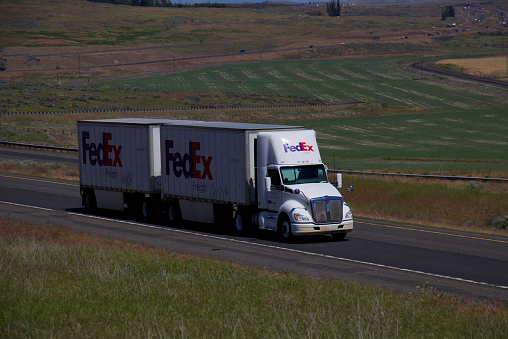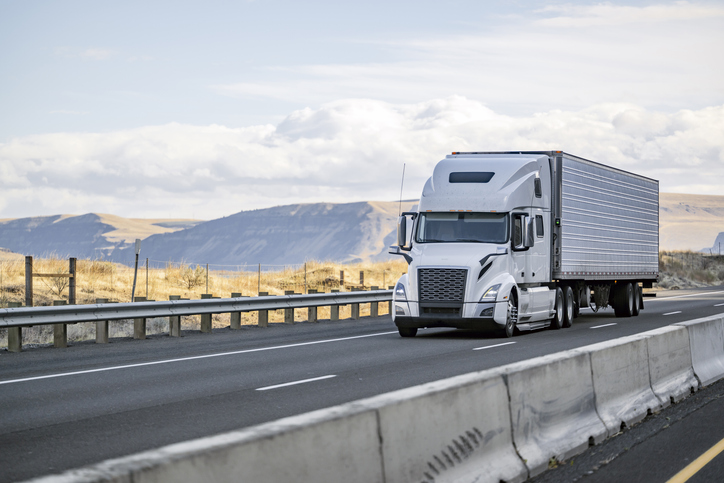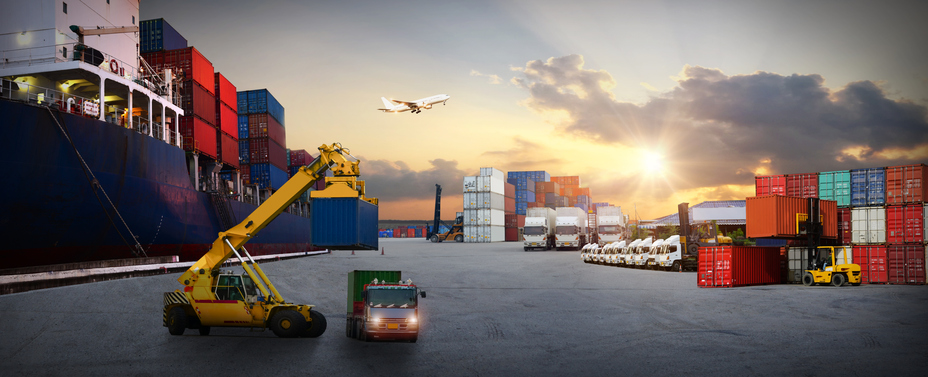When it comes to shipping freight, shippers must consider size, speed, and price when deciding between Full Truckload (FTL) and Less Than Truckload (LTL) shipping. FTL is typically more expensive than LTL but offers faster delivery times for large shipments and is more cost-effective when looking at the cost of transporting each item when a truck is full when compared to shipping an LTL shipment. On the other hand, LTL requires less of a cash outlay because of shipping fewer items. Their delivery times typically are also slower as multiple shipments are consolidated on the same truck and then taken to another terminal where they are broken out and then placed on a truck for final delivery.
In this article, we will delve deeper into the main differences between LTL vs FTL shipments, providing a comprehensive understanding of which shipping method suits your needs best. We will examine the advantages and disadvantages of each type of shipping, as well as the optimal scenarios for their utilization.
Comparison of FTL versus LTL
FTL trucking, also known as full truckload, is a shipping method that involves filling an entire trailer with your own goods. This is different from LTL (less than truckload) freight, which is used typically for shipments of less than 10,000 pounds or 10 pallet spaces (varies by carrier). The main distinction lies in the size and handling of the shipments.
FTL is typically used for large shipments of 10,000 pounds or more or more than 10 pallet spaces that require a full truckload (typically up to 44,000 pounds). With FTL, the entire trailer is dedicated to your shipment, providing faster delivery times as there are fewer stops and no need for unloading and reloading at transfer points. This direct approach ensures that your cargo remains securely in the same truck from origin to destination.
On the other hand, LTL freight, which stands for 'less than truckload,' is better for smaller shipments. It consolidates multiple shipments onto the same truck, allowing shippers to share the transportation costs. By combining several shipments that do not require the full space of a truck, LTL freight is an efficient way to maximize the use of trailer space. This method not only reduces shipping costs by allowing shippers to pay only for the portion of the trailer used, but it also minimizes wasted space and 'empty miles.' However, this consolidation does lead to slower delivery times as the truck makes more stops to accommodate different shipments, and cargo must often be unloaded and reloaded at various transfer points. It's important to note that this shared space can also increase the risk of theft or damage, as multiple shipments are transported together.
In summary, FTL trucking is suitable for larger shipments that require a full truckload, offering faster delivery times and increased security. On the other hand, LTL freight is more cost-effective for smaller shipments, but comes with slower delivery times and decreased security due to sharing the truck with other shipments. Understanding the differences between FTL and LTL can help you make informed decisions when it comes to your shipping needs.<
Advantages and Disadvantages of FTL and LTL Shipping
FTL shipping has several advantages over LTL. FTL offers faster delivery times since goods are transported directly to their destination without any stops or transfers, greatly speeding up the transit process. It also provides greater security and fewer handling points, reducing the risk of damage or mishandling since your shipment is loaded onto one truck and only handled again upon reaching its destination. This minimizes the chances of your goods being moved around to accommodate other shipments.
Furthermore, FTL is more flexible as there are limited restrictions on the size and weight of the cargo, accommodating larger and heavier shipments easily. FTL also has a lower cost per unit when compared to shipping only one pallet on an LTL shipment. This cost-efficiency arises because FTL shipments require fewer transactions and loading/unloading processes, generally making them more efficient and cost-effective than LTL shipments. This makes FTL trucking an attractive option for shippers transporting large loads, looking for both economic and logistic advantages.
Use Cases for LTL vs FTL
FTL is the preferred option for large shipments that must be delivered quickly. FTL is also ideal for high-value or sensitive cargo that requires enhanced security. FTL is typically used for shipments of 10,000 pounds or more.
LTL is best suited for small and medium-sized shipments that don’t need to be delivered urgently. LTL is also ideal for shipments that require consolidation at transfer points and have a lower value or are less sensitive. LTL is typically used for shipments of less than 10,000 pounds.
Tips for Successful Freight Transport with FTL or LTL Shipments
- Choose the right carrier: When it comes to freight transport, it is crucial to choose the right carrier that offers the best value for money. Factors such as delivery time, reliability, and cost should be considered when making your selection. Choosing the lowest price does not always provide the service you need.
- Properly package and label your shipment: Proper packaging and labeling of your shipment can help prevent damage during transit and ensure that your shipment arrives at its destination on time. Make sure to use sturdy boxes and packaging materials, and clearly label your shipment with the recipient's name and address.
- Accurately document and communicate the shipment details: Accurate documentation and communication of the shipment details can help prevent delays and ensure that your shipment arrives on time. This includes providing a complete and accurate packing list, shipment weight, and dimensions.
- Choose the right mode of transportation: Depending on your shipment's size, weight, and delivery time requirements, you may need to choose between FTL vs LTL shipment.
- Monitor your shipment: It's important to monitor your shipment throughout the transportation process. This includes tracking its progress, making sure that it is delivered on time, and addressing any issues that may arise during transit. This can be done through online tracking systems or by contacting your carrier directly.
Freight Shipping
When using LTL vs FTL to transport freight, it’s important to consider size, speed, and price. The right choice will depend on the specifics of each shipment. FTL should be used for large shipments that require faster delivery times while LTL should be used for smaller shipments that don’t need to be delivered urgently. It’s also important to conduct research and compare prices from different carriers before making a decision.
By understanding the differences between FTL and LTL shipping, shippers can ensure that their freight is transported safely and efficiently at the best price. Armed with this knowledge, shippers will be able to make informed decisions when it comes to FTL versus LTL freight transportation.
What are the drawbacks of FTL trucking when compared to LTL trucking?
Full truckload shipping offers cost-effectiveness in comparison to less-than-truckload (LTL) shipping; however, it comes with its set of challenges.
First, to make the most of the cost savings in full truckload shipping, companies need to order in large quantities, which can require a significant upfront investment in inventory. In contrast, LTL allows for the shipment of smaller quantities, offering a more flexible and financially manageable option.
Second, the responsiveness of full truckload carriers is a drawback, as they may struggle to accommodate last-minute requests due to the rigid nature of their operations.
Finally, external factors such as mechanical issues, border delays, or unexpected delays from previous loads can impact the on-time pickup and delivery of full truckload shipments. LTL carriers, with their set schedules and terminal-to-terminal consistency, have a high on-time performance for delivering less-than-truckload freight. As businesses weigh the trade-offs between cost efficiency and flexibility, these drawbacks highlight the importance of selecting the right shipping solution based on specific logistical needs.
How can a Transportation Management System (TMS) help Determine the Best Shipping Method for a Business?
A transportation management system (TMS) can greatly assist businesses in determining the most suitable shipping method for their needs. By integrating a TMS into their logistics operations, businesses gain access to a comprehensive platform that consolidates a vast amount of data and provides unparalleled visibility. This aggregation of data into a centralized dashboard is particularly beneficial as it simplifies the decision-making process regarding shipping methods, enabling businesses to accurately analyze key factors such as the nature of the shipment, load size, and desired delivery timeframe. This allows them to make informed decisions regarding the most appropriate shipping method - whether it is less-than-truckload (LTL) or full truckload (FTL).
The TMS system streamlines the process by aggregating various data sources into a centralized dashboard. Through this user-friendly interface, businesses can easily optimize shipping loads by assessing available carrier options for both LTL and FTL. By comparing rates, transit times, and carrier availability, businesses can make an informed decision on which shipping method is best suited for their specific requirements.
Additionally, the TMS system facilitates seamless communication with both LTL and FTL carriers. This direct line of communication ensures that businesses have access to real-time updates on shipment status, enabling them to track and monitor the progress of their deliveries. Furthermore, the exceptional visibility provided by the TMS helps businesses to optimize their shipping loads and communicate effectively with LTL and FTL carriers, determining the best route possible for the shipment.
In determining the best route for a shipment, a TMS offers tremendous value. By leveraging advanced algorithms and analytics, businesses can optimize their shipping routes to minimize costs, reduce transit times, and enhance overall efficiency. The TMS platform takes into account various factors such as distance, traffic conditions, carrier capacity, and delivery deadlines to suggest the most optimal route for each shipment. This comprehensive approach ensures that every decision is backed by detailed data and tailored to meet the specific logistics needs of the business.
Many companies though don't have the internal resources or it is not their highest priority to implement a TMS. In this case, Visigistics has several options that we can utilize to provide this capability. If interested, we would be glad to talk about a managed transportation service to provide this value to your business that will impact your bottom line without disrupting your business. By leveraging data and technology, Visigistics enables businesses to access an all-inclusive TMS system that empowers them to make informed decisions about the most appropriate shipping method for their unique requirements. Reach out to us today, and let us guide you on how our TMS solutions can make the shipping process easier and more efficient for your business.
Other Frequently Asked Questions
What are the specifications for Less Than Truckload (LTL) freight transport?
Less Than Truckload (LTL) freight transport typically involves shipping 1 to 3 non-stackable pallets or up to 6 stackable pallets of standard sizes. These standard pallet sizes are usually around 48 inches in length, 40 inches in width, and 48 inches in height. Additionally, the total weight of the load for LTL shipping should generally be around 10,000 pounds, equivalent to approximately 4.5 tons. Shipments over 7 pallets can also be shipped via LTL but typically require a volume quote.
What is the difference between FTL, Partial truckload, and LTL freight shipping?
FTL, Partial truckload (PTL), and LTL are three common types of freight shipping services distinguished by the size and nature of the cargo being transported. Full truckload (FTL) shipping is typically suited for large and heavy loads that occupy an entire trailer or the majority of its space, making it an efficient choice for shipping bulk items or when time is of the essence. Partial truckload (PTL) shipping is recommended when the cargo occupies less than 30 linear feet of the trailer, making it a cost-effective option for shipments that are larger than LTL but don't require an entire truck. Lastly, Less than Truckload (LTL) shipping is the preferred method for smaller loads that do not require a full trailer, as it allows multiple shippers to share space on the same truck, thereby reducing costs for individual shipments. Each option offers specific advantages based on the size and volume of the freight being transported, providing flexibility and cost-efficiency for various shipping needs.
What are the characteristics, advantages, and disadvantages of FTL, Partial Truckload, and LTL freight shipping services?
When examining freight shipping services such as Full Truckload (FTL), Partial Truckload, and Less than Truckload (LTL), it is crucial to understand their unique characteristics, advantages, and disadvantages. Each service caters to specific shipping requirements and demands distinct considerations.
Full Truckload (FTL) services involve the transportation of goods that fill an entire truck, offering a high level of security and minimal handling since the shipment remains on the same truck throughout the journey. This option is ideal for transporting large quantities of goods over long distances efficiently. However, the main disadvantage of FTL is the higher cost associated with booking an entire truck, making it less economical for smaller shipments.
Partial Truckload services fall between FTL and LTL, offering a cost-effective solution for shipments that are larger than LTL but do not require an entire truck. This option provides a balance between cost-efficiency and faster transit times compared to LTL. One key advantage of Partial Truckload is the reduced risk of damage or loss compared to LTL shipments, as the goods are typically handled less during the transportation process.
Less than Truckload (LTL) services are designed for smaller shipments that do not require a full truck. LTL is often more cost-effective for businesses shipping smaller quantities, as they only pay for the space their goods occupy on the truck. However, the main disadvantage of LTL is the increased risk of damage or misplacement due to multiple stops and handling throughout the delivery process.
In terms of characteristics, FTL offers maximum security and efficiency for large shipments but at a higher cost, while Partial Truckload strikes a balance between cost and transit time, and LTL caters to smaller shipments with cost-effectiveness in mind. Understanding these distinctions can help companies make informed decisions based on their specific freight transportation needs, whether it be maximizing cost savings, ensuring faster delivery times, or prioritizing the safety of goods during transit.
What is the maximum capacity of the Full Truckload, Partial Truckload, and Less than Truckload services?
The Full Truckload service is suitable for large and heavy loads that occupy all or most of the trailer. If less than 30 linear feet of the trailer will be occupied, the Partial Truckload service is the most cost-effective option. For smaller loads, the best choice is the Less than Truckload service. These distinctions help determine the maximum capacity for each type of service: Full Truckload for large and heavy loads, Partial Truckload for loads occupying less than 30 linear feet, and Less than Truckload for smaller shipments. Contact Visigistics today if you need more information.
What are the benefits of LTL Freight Shipping?
Exploring how LTL (Less Than Truckload) freight shipping can positively impact your business reveals several key benefits:
Cost Efficiency
In LTL shipping, you only pay for the space your cargo occupies, not the entire trailer. This method pools the shipments of different customers, spreading the transportation costs and offering lower shipping rates. By sharing a trailer, businesses avoid the expenses of transporting partially empty vehicles, thereby enhancing cost efficiency.
Enhanced Fuel Economy
LTL shipping is also environmentally friendly. By consolidating shipments, fewer trucks are required to transport the same amount of goods, compared to each shipper using individual trucks. This consolidation maximizes the cargo carried per litre of fuel used, significantly reducing fuel consumption per shipped unit and contributing to lower emissions.
Flexibility and Efficiency
LTL shipping stands out for its adaptability. Businesses can ship goods faster by not having to wait for enough products to fill an entire truckload, which is particularly valuable for businesses with smaller quantities of goods or tighter delivery schedules. This flexibility helps maintain steady supply chains and responsive customer service.
Tracking Capabilities
Enhanced tracking is another significant benefit. LTL carriers often provide detailed tracking systems that enable businesses to see the live status of their shipments. Having access to real-time data about the location and estimated arrival time of goods helps businesses manage logistics more effectively and keep customers informed about their orders' status.
In sum, LTL Freight Shipping provides considerable economic and logistical advantages, making it a preferred choice for businesses looking to optimize their shipping processes while cutting costs and increasing operational flexibility.
How can a 3PL (third-party logistics provider) assist in navigating the complexities of LTL and FTL shipping decisions?
Navigating the complexities of freight shipping can be challenging, whether it involves Less Than Truckload (LTL) or Full Truckload (FTL) options. This is where a third-party logistics provider (3PL) can be invaluable. A 3PL offers specialized expertise and resources that can transform your logistics operations from confusing to streamlined. Here’s how:
- Expert Guidance: 3PLs are experts in logistics and understand the nuances of both LTL and FTL shipping. They can provide tailored advice based on your specific shipping needs and help you make informed decisions.
- Resource Allocation: With access to a wide network of carriers and shipping options, 3PLs can optimize the logistics process. They handle the complexities of coordinating different freight options, ensuring that your cargo is transported efficiently and cost-effectively.
- Risk Management: 3PLs manage risks associated with transportation and logistics. They ensure compliance with shipping regulations and handle any unforeseen issues that might arise during transit, such as delays or damage.
- Scalability and Flexibility: As your business grows, a 3PL can readily scale up their services to accommodate increased demand. They can also adjust to seasonal fluctuations, providing more capacity when needed and reducing it when it’s not.
- Overall Success: By outsourcing your logistics to a 3PL, you can focus more on core areas of your business. A reliable 3PL not only ensures the smooth handling of your shipments but also contributes to the overall success by enhancing operational efficiency.
In summary, utilizing a 3PL for your freight shipping strategy, whether it’s LTL or FTL, streamlines your business’s logistics operations, mitigates risks, and offers flexibility to adapt to business needs. This strategic move ensures the success and efficiency of your business's logistical requirements.
What are the differences in special service and equipment requirements when comparing LTL and FTL freight options?
When choosing between Less Than Truckload (LTL) and Full Truckload (FTL) shipping methods, it's essential to consider their distinct differences in terms of special service and equipment requirements.
Special Service Requirements:
- LTL Shipping: This method is more adaptable if your shipment needs extra services. LTL is ideal for handling high-maintenance deliveries, including:
- White glove services (special care and handling).
- Lift gate services for loading and unloading without a docking facility.
- Freeze protection for temperature-sensitive goods.
These services are often readily available because LTL shipments typically handle smaller, more diverse loads that may require special handling.
- FTL Shipping: With FTL, the freight occupies the entire truck. Services are generally more straightforward and less specialized compared to LTL:
- The focus is primarily on getting a large volume of goods from one point to another with less need for extra handling services.
- While some special services can be arranged, they are not as commonly required or as easily integrated as with LTL shipments.
Equipment Requirements:
LTL carriers typically have equipment designed for more complex service needs, such as multiple access points for different shipments in one truck. FTL, however, often involves simpler, larger transport vehicles that are utilized for bulk shipping, reducing the need for specialized equipment.
Key Takeaways
Choosing between LTL and FTL largely depends on the particular needs of your shipment. If your freight is smaller or requires special handling, LTL provides the flexibility and services needed. Conversely, FTL is suitable for larger, straightforward shipments where volume is the priority and less customization is required. This efficiency often translates into faster shipment times but with fewer service bells and whistles.
What are volume shipping and partial truckloads, and how do they fit into the LTL vs. FTL decision-making process?
In the landscape of freight transportation, two terms you may frequently encounter are "volume shipping" and "partial truckloads." Both play pivotal roles in the decision-making process when choosing between Less Than Truckload (LTL) and Full Truckload (FTL) shipping. Here’s a deeper look into each and how they fit into the broader context of freight options.
Volume Shipping: Volume shipping essentially falls under the LTL umbrella but is specifically designed for larger shipments that do not require a full truckload. Typically, this involves freight that occupies more space than what is typical for LTL but still does not fill an entire truck, generally taking up more than six pallets and weighing between 8,000 to 10,000 pounds. This option can be significantly more cost-effective compared to FTL, especially for businesses that don't have enough goods to necessitate a full truck but exceed the usual specifications for standard LTL.
Partial Truckloads: On the FTL spectrum, partial truckloads cater to shippers who have more goods than what can be accommodated by volume shipping but still less than what is required for a full truckload. These typically involve freight that spans about 8 to 18 pallets weighing anywhere from 8,000 to 27,500 pounds. The key advantage of partial truckloads is that they often blend the benefits of both LTL and FTL—offering faster delivery times than LTL by sharing the space in the truck with other shipments but without filling a full truck.
Deciding Between LTL and FTL: Where Do Volume and Partial Truckloads Fit?
When deciding between LTL and FTL, businesses need to consider the specifics of their shipment volume and weight. Volume shipping and partial truckloads provide flexible solutions for those in-between needs. They help in optimizing transportation costs while ensuring timely delivery, depending on the quantity and urgency of the shipment.
By understanding the differences and uses of volume shipping and partial truckloads, businesses can better navigate their shipping strategies and make informed choices that align with their logistical requirements and budget constraints.
How does cargo fragility influence the choice between LTL and FTL shipping options?
The decision between Less Than Truckload (LTL) and Full Truckload (FTL) shipping can significantly depend on the fragility of the cargo in question. When dealing with delicate items that require minimal handling to prevent damage or loss, FTL shipping emerges as a preferable choice. This method ensures that the cargo occupies the entire space of the truck, thereby reducing the risks associated with frequent handling and movement that typically occur in LTL shipments, where goods are consolidated with others. Consequently, choosing FTL can be a strategic decision to protect fragile goods during transit.
What do the acronyms LTL and FTL stand for in the world of freight shipping?
In the freight shipping industry, two common terms you'll come across are LTL and FTL. These acronyms are essential for understanding how cargo is transported by truck.
LTL stands for Less-Than-Truckload. This method is used when the freight does not require the full space of a truck. It's ideal for shipping smaller quantities or when deliveries are being made to multiple destinations.
FTL, on the other hand, stands for Full Truckload. This approach is used when the cargo is sufficient to fill an entire truck, or when a single shipment needs to be transported directly from the sender to the receiver without additional stops.
Both terms are crucial in determining the most efficient and cost-effective method for freight transportation.
How does security concern factor into the decision between LTL and FTL shipping, especially for international freight?
Security is a crucial consideration when deciding between LTL and FTL shipping, especially for international freight. FTL shipping offers greater security as the entire trailer is dedicated to your shipment, reducing the risk of theft or damage during transit. This direct approach ensures that your cargo remains securely in the same truck from origin to destination. On the other hand, LTL freight, which consolidates multiple shipments onto the same truck, increases the risk of theft or damage as the cargo is transported together with other shipments. When it comes to international freight, the security of the shipment becomes even more critical due to the longer transit times and potential exposure to various handling points.
Given these considerations, if security is a primary concern and the value of your shipment is considerable, it may be worth investing in FTL shipping. The peace of mind that comes with knowing your goods are transported securely and with less handling can significantly outweigh the additional costs associated with FTL. Therefore, if minimizing risk and ensuring the safety of your cargo throughout its journey are top priorities, opting for FTL shipping would be the preferred choice to safeguard your shipment during international transit.
How can Visigistics help in providing resources, carrier partnerships, and expertise for both LTL and FTL shipping needs?
Visigistics is uniquely equipped to support your shipping requirements, whether you need full truckload (FTL) or less-than-truckload (LTL) services. With a vast network of LTL carriers and FTL carriers, they ensure a wide range of shipping options to meet diverse demands. Additionally, Visigistics enhances your shipping process with robust warehousing and fulfillment solutions, ensuring that your products are not only transported efficiently but also managed and stored with professional care. For those uncertain about the optimal shipping method for their needs, Visigistics provides specialized guidance to navigate the complexities of FTL and LTL shipping options effectively.





